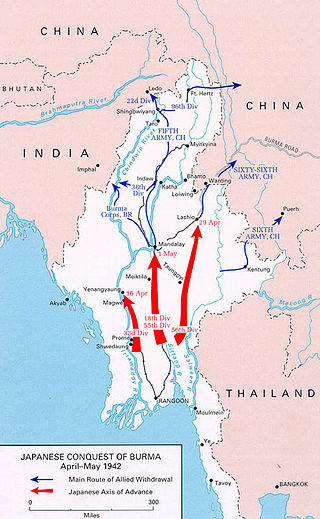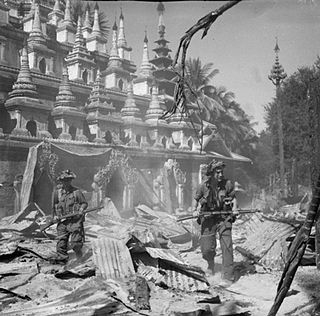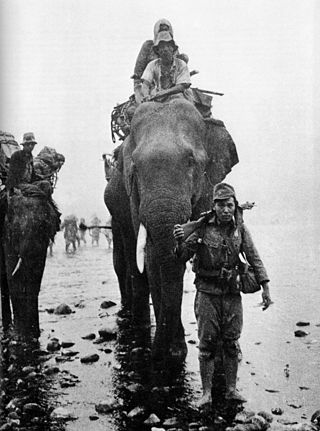
The British Fourteenth Army was a multi-national force comprising units from Commonwealth countries during the Second World War. As well as British Army units, many of its units were from the Indian Army and there were also significant contributions from the British Army's West and East African divisions. It was often referred to as the "Forgotten Army" because its operations in the Burma campaign were overlooked by the contemporary press, and remained more obscure than those of the corresponding formations in Europe for long after the war. For most of the Army's existence, it was commanded by Lieutenant-General William Slim.

The Burma campaign was a series of battles fought in the British colony of Burma. It was part of the South-East Asian theatre of World War II and primarily involved forces of the Allies against the invading forces of the Empire of Japan. Imperial Japan was supported by the Thai Phayap Army, as well as two collaborationist independence movements and armies. Nominally independent puppet states were established in the conquered areas and some territories were annexed by Thailand. In 1942 and 1943, the international Allied force in British India launched several failed offensives to retake lost territories. Fighting intensified in 1944, and British Empire forces peaked at around 1 million land and air forces. These forces were drawn primarily from British India, with British Army forces, 100,000 East and West African colonial troops, and smaller numbers of land and air forces from several other Dominions and Colonies. These additional forces allowed the Allied recapture of Burma in 1945.

The Battle of Imphal took place in the region around the city of Imphal, the capital of the state of Manipur in Northeast India from March until July 1944. Japanese armies attempted to destroy the Allied forces at Imphal and invade India, but were driven back into Burma with heavy losses. Together with the simultaneous Battle of Kohima on the road by which the encircled Allied forces at Imphal were relieved, the battle was the turning point of the Burma campaign, part of the South-East Asian theatre of World War II. The Japanese defeat at Kohima and Imphal was the largest up until that time, with many of the Japanese deaths resulting from starvation, disease and exhaustion suffered during their retreat. According to voting in a contest run by the British National Army Museum, the Battle of Imphal was bestowed as Britain's Greatest Battle in 2013.

Brigadier Sir John George Smyth, 1st Baronet,, often known as Jackie Smyth, was a British Indian Army officer and a Conservative Member of Parliament. During WWII, he led a unit in France and during the evacuation of Dunkirk, and in the Burma campaign. Although a recipient of the Victoria Cross, his military career ended in controversy.

Operation Dracula was a World War II-airborne and amphibious attack on Rangoon by British and Anglo-Indian forces during the Burma Campaign.

General Sir Montagu George North Stopford, was a senior British Army officer who fought during both the First and Second World Wars. The latter he served in with distinction, commanding XXXIII Indian Corps in the Far East, where he served under General Sir William Slim, and played a significant role in the Burma Campaign, specifically during the Battle of Kohima in mid-1944.

The concurrent Battle of Meiktila and Battle of Mandalay were decisive engagements near the end of the Burma campaign during World War II. Collectively, they are sometimes referred to as the Battle of Central Burma. Despite logistical difficulties, the Allies were able to deploy large armoured and mechanised forces in Central Burma, and also possessed air supremacy. Most of the Japanese forces in Burma were destroyed during the battles, allowing the Allies to later recapture the capital, Rangoon, and reoccupy most of the country with little organised opposition.

The 17th Infantry Division is a formation of the Indian Army. During the Second World War, it had the distinction of being continually in combat during the three-year-long Burma Campaign. The division was re-raised in 1960 and the 17 Mountain Division is presently located in Sikkim under XXXIII Corps.

The Battle of Yenangyaung was fought in Burma from 16 to 19 April 1942. As part of the Burma Campaign of World War II, the battle was fought between Chinese and British allied forces on one side and Japanese forces on the other. The battle took place in the vicinity of Yenangyaung and its oil fields.

The Battle of Pakokku and Irrawaddy River operations were a series of battles fought between the British Indian Army and the Imperial Japanese Army and allied forces over the successful Allied Burma campaign on the China Burma India Theater during World War II. The battles and operations were instrumental in facilitating the eventual capture of Rangoon in summer 1945.
The Battle of Toungoo was one of the key battles in the Battle of Yunnan-Burma Road in the Burma Campaign of World War II and Second Sino-Japanese War. The failure of the Chinese to hold the city of Toungoo opened up the route for the Japanese to make their lunge to Lashio around the allied flank and into the Chinese rear.

The Japanese invasion of Burma was the opening phase of the Burma campaign in the South-East Asian theatre of World War II, which took place over four years from 1942 to 1945. During the first year of the campaign, the Japanese Army drove British Empire and Chinese forces out of Burma, then began the Japanese occupation of Burma and formed a nominally independent Burmese administrative government.

The Burma campaign in the South-East Asian Theatre of World War II was fought primarily by British Commonwealth, Chinese and United States forces against the forces of Imperial Japan, who were assisted by the Burmese National Army, the Indian National Army, and to some degree by Thailand. The British Commonwealth land forces were drawn primarily from the United Kingdom, British India and Africa.

The Japanese 33rd Army was an army of the Imperial Japanese Army during the final days of World War II.

Major General David Tennant Cowan,, also known as "Punch" Cowan, was an officer in the British Army and British Indian Army during the First and Second World Wars. He led the 17th Indian Infantry Division during almost the entire Burma campaign.

The Battle of Sittang Bridge was part of the Burma campaign during the Second World War. Fought on 22 and 23 February 1942, the battle was a victory for the Empire of Japan, with many losses for the British Indian Army, which was forced to retreat in disarray. Brigadier Sir John George Smyth, V.C.—who commanded the British Indian Army at Sittang Bridge—called it "the Sittang disaster".
The Battle of Pegu was an engagement in the Burma campaign in the Second World War. Fought on 6 and 7 March 1942, it concerned the defence of Rangoon in Burma. Japanese forces closed in on the British Indian Army who were deployed near Pegu.

The Arakan campaign of 1942–1943 was the first tentative Allied attack into Burma, following the Japanese invasion of Burma earlier in 1942, during the Second World War. The British Army and British Indian Army were not ready for offensive actions in the difficult terrain they encountered, nor had the civil government, industry and transport infrastructure of Eastern India been organised to support the Army on the frontier with Burma. Japanese defenders occupying well-prepared positions repeatedly repulsed the British and Indian forces, who were then forced to retreat when the Japanese received reinforcements and counter-attacked.
The Burma Corps ('Burcorps') was an Army Corps of the Indian Army during the Second World War. It was formed in Prome, Burma, on 19 March 1942, took part in the retreat through Burma, and was disbanded on arrival in India in May 1942.

The Battle of the Sittang Bend and the Japanese Breakout across Pegu Yomas were linked Japanese military operations during the Burma Campaign, which took place nearly at the end of World War II. Surviving elements of the Imperial Japanese Army who had been driven into the Pegu Yoma attempted to break out eastwards in order to join other Japanese troops retreating from the British forces. The break-out was the objective of the Japanese Twenty-Eighth Army with support at first from the Thirty-Third Army and later the Fifteenth Army. As a preliminary, the Japanese Thirty-Third Army attacked Allied positions in the Sittang Bend, near the mouth of the river, to distract the Allies. The British had been alerted to the break-out attempt and it ended calamitously for the Japanese, who suffered many losses, with some formations being wiped out.















